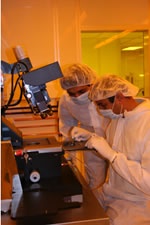May 26 2009
The city of Morgantown, West Virginia, home to West Virginia University, is making national headlines as an "economic oasis." It is one of the few U.S. locations to be successfully isolated from the current recession, offering diverse opportunities for employment and research plus a low cost of living.

Isolation of another kind is occurring in the University's Nanosystems Engineering Shared Cleanroom (NESC), where Dr. Kolin Brown is installing a new e-beam lithography/scanning electron microscope (SEM). Outfitted with a customized acoustic enclosure to isolate it from the constant background noise, vibration, and magnetic interference of the class 10,000 clean room, the new SEM will do double duty. As an e-beam lithography system, it will produce precise patterns and features just nanometers in width on silicon substrates. As an SEM, it will allow students and researchers to examine nanowires linked to extremely small components at ultrahigh resolution and magnifications up to 1,000,000X. This level of precision will be demanded around the clock in a multiuser environment that also contains polymer spinners, wet development benches, and plasma etch tools.
"This is going to be a very hot instrument that a lot of people will want to come and use," said Brown, Research Program Coordinator for WVU's clean room. "Our goal is to have the best SEM on campus." The lithography capability makes it even more exciting. "One of our questions is, how small can we go? Sometimes we're talking sixty to seventy nanometer patterns or just ten to twelve nanowires."
Through a National Science Foundation Grant that was matched by a grant from the state of West Virginia, the analytical field emission SEM is part of the University's vigorous WVNano Initiative, giving researchers and students from multiple disciplinary fields the tools and facilities they need to develop new biosensors, semiconductor devices, structures, and photonic crystals. Replacing an antiquated but dedicated e-beam lithography tool on another part of the large campus, the new SEM will allow rapid proof of design and application testing.
From undergraduates to post docs, exposure to the JEOL JSM-7600F field emission analytical SEM is the opportunity to use the most advanced analytical electron microscope technology available today. Additionally, outside researchers working within West Virginia's higher educatin system or industry will be given access.
"We're not just multidisciplinary but interdisciplinary," said Christie Zachary, Public Relations Specialist at WVNano. "At West Virginia University we offer everything from toxicology to orthopedics. We're responsible for building an infrastructure and educating students so they can get out into the workforce. We're changing our culture and emerging as a resource for true interdisciplinary research, and changing people's perspective of industry. Ours is more of a group culture."
Dr. Brown adds, "The interests of our students are so vast. They are studying materials, or looking at the biomedical side of early cancer detection, where a lot of our work is looking at delivery of organic materials to sensors to create devices that act as unique sensors. These biomaterials may be used for detection of viruses or pathogens for homeland security. Other times we're just trying to create a method of measuring new materials interaction. We do everything from pure to applied sciences."
The new SEM will be part of that initiative. By outfitting it with a JC Nabity pattern generator, the NESC has optimized the performance of this instrument as a lithography tool. Housed in the NESC busy clean room environment, a sealed and temperature-controlled acoustical chamber will protect the electron optics column and precision electron beam generation from outside interferences. JEOL engineers and West Virginia University engineers met with Integrated Dynamics Engineering (IDE) to custom fit the enclosure for easy access, minimal use of space, robust sealing of the panels for repeated opening and closing, uncompromising temperature stability, and failsafe noise dampening. IDE's AKH panel technology is an evolutionary blend of material and construction to achieve optimal acoustic isolation.
Continually upgrading and adding to their capabilities, West Virginia University plays a key role in the state's economic success. "West Virginia University has always been at the top of the list for building economic development in West Virginia. The state saw that WVNano had a real plan and really pushed us into a plan for the state, which has been best known for coal and agricultural. Now it's nanoscience. People here can do top notch research."